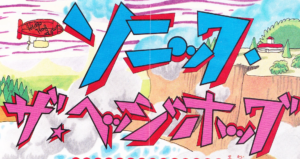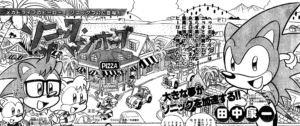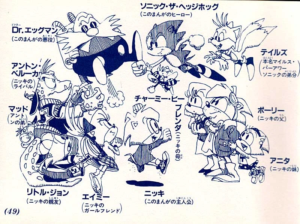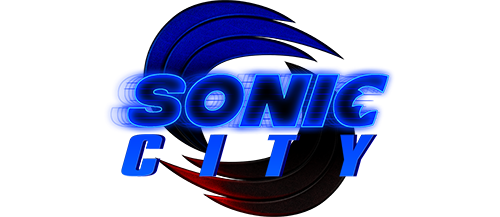in: Manga
Sonic the Hedgehog (manga)
This article is about the 1992 manga series. For other Sonic manga series, see manga.

Sonic the Hedgehog (ソニック・ザ・ヘッジホッグ Sonikku za Hejjihoggu) is a manga series that was serialized in Shogakukan’s Study Magazine (小学館の学習雑誌 Shōgakukan no Gakushū Zasshi) for primary school children and Bessatsu CoroCoro Comic Special (別冊コロコロコミックSpecial Bessatsu Korokoro Komikku Special). It was published in Japan between 1992 and 1994. The series is loosely based on the video game series, with an original story concept developed by Kenji Terada.[1]Overview of manga’s publication. Sonic the Hedgehog Manga. Archived from the original on 25 November 2011. Retrieved on 1 April 2015.
Sega of Japan’s marketing department devised the strategy to get the Sonic manga published by Shogakukan to appeal to primary school children. The Sega of Japan design team was involved in the creation of the characters.[2]Summer of Sonic 2013 – Kazuyuki Hoshino Q&A. YouTube. The Sonic Show (4 August 2013).
The first comic story was published in the April 1992 issue of Shogaku Ninensei (小学二年生 Shōgaku ni Nensei).
Overview

The serialized manga takes place in Hedgehog Town, where a young hedgehog named Nicky lives. Nicky has the ability to turn into Sonic the Hedgehog, as this incarnation of the main character is Nicky’s alternate persona. In this town, Sonic, along with Miles “Tails” Prower and Charmy Bee, arises to challenge Dr. Eggman. The serialized manga features Nicky with several friends in Hedgehog Town, including his girlfriend Amy and his best friend Little John. Nicky also encounters a lizard bully named Anton Veruca and his brother Mad. Nicky’s family includes his mother, Brenda, his father, Paulie, and his little sister, Tania. Except for Tails, nobody knows that Nicky is actually Sonic the Hedgehog, not even Nicky himself.
Each manga strip follows a simple and recurrent plot: Nicky is a peaceful boy who enjoys spending time with his beloved girlfriend Amy, his sister Tania, and his friend Little John. However, his peace is often disrupted by Dr. Eggman’s schemes or the troublemaker Anton Veruca. Amy encourages Nicky to stand up to the bad guys, but Nicky, being shy and somewhat cowardly, often fails, with Amy usually ending up as a captive. However, Nicky’s desire to save Amy and be victorious transforms him into the supersonic hero Sonic, who saves the day in no time.
There are a few misunderstandings regarding the figure of the heroic Sonic, who succeeds where Nicky fails. This makes Amy long for Sonic more than Nicky on several occasions, causing Nicky to feel jealous of himself. Eventually, Dr. Eggman and Anton Veruca start suspecting that Nicky has something to do with Sonic, but Nicky simply replies that he does not even know the blue hedgehog everyone is talking about.
Characters
Main Characters

- Nicky: A sweet and even-tempered hedgehog. His biggest dream is to defeat the forces of evil and be considered a hero; unfortunately, he is weak and a bit of a coward. Even if the people near him believe in him, he doesn’t have the nerve to take action, which is why he is often bullied by Anton or Eggman. Romantic and reflective, Nicky loves to spend time with his girlfriend and his friends. Even though Nicky doesn’t have the strength to save the day, when his help is really required, he will eventually transform into his alter-ego, Sonic.
- Sonic the Hedgehog: Cocky and overconfident, Sonic seems to be the exact opposite of Nicky. Sonic always arrives just in the nick of time to save the day and knows exactly what must be done. Sarcastic and heroic, he appears to be perfect. Interestingly, he has a conscience and a memory of his own that seems to have nothing to do with Nicky’s, explaining Nicky’s obliviousness to Sonic’s existence.
- Doctor Eggman: A genius mad scientist who, with the aid of his machines and robot minions, aims to unlock the secret of Sonic’s powers and conquer the world. A master of disguise, Eggman frequently uses costumes to deceive and trap Nicky and his friends. Recurring disguises include a traffic cop and a postman.
- Miles “Tails” Prower: A two-tailed fox who knows Sonic and tries to follow him everywhere, even calling him his big brother. In his introduction in the CoroCoro comics, he is shown with a bit of attitude, wearing sunglasses and owning a sports car. Since then, he becomes either a good partner for Nicky or a sidekick for Sonic, helping him out of many situations. Often, he also gets captured or into trouble along with the rest of the group.
- Amy Rose: Nicky’s close friend and romantic interest. Amy cares a lot for Nicky but wishes he could be braver, like Sonic.
- Anton Veruca: He claims to be the number one hooligan of the city. Spiteful and arrogant, he enjoys creating trouble, particularly targeting poor Nicky, who is unable to protect himself and his friends from him. He fiercely teases and embarrasses Nicky whenever he tries to react. However, he also enjoys troubling all the people dear to Nicky, such as Little John and, most of all, Amy, for whom he shows an attraction. His worst enemy is Sonic, the only one who can defeat him without breaking a sweat. Often, he swears revenge at the end of the story but is never able to do anything against the supersonic hero. Nicky fears him and often wishes to be strong and old enough to beat him, but he doesn’t dare to defy him, as he is too afraid. When he tries, he quickly gets knocked unconscious.
- Charmy Bee: A small bee who becomes friends with Nicky and the other kids.
Recurring Characters
- Tania/Anita: A young hedgehog with a tomboy attitude. She is usually seen with her brother Nicky and his friends. She is a good friend of Amy and sometimes acts like a little sister to her. Tania likes to tease people in an innocent way. Unlike her brother, she has more nerve. In a story where she was captured by Eggman, she was not only unafraid but actually amused by how she could push around the villain’s robots to do her bidding. She is usually named Tania, except in stories written by Sango Morimoto, where she is named Anita.
- Little John: Nicky’s best friend. A fat and gluttonous hedgehog, he spends most of his time eating.
- Brenda: Nicky’s mother, who is rarely shown during the comic’s run.
- Paulie: Nicky’s father. Formerly a supersonic jet test pilot, Paulie now pilots a mail-carrying seaplane. Nicky admires him greatly and wishes to grow up to be as strong and courageous as he is.
- Mad: One of Anton Veruca’s younger brothers, often seen carrying a toy hammer.
- Tod: One of Anton Veruca’s younger brothers, who always has a dazed expression and half-closed eyes.
- Hud: One of Anton Veruca’s younger brothers.
- Migu: Anton Veruca’s younger sister.
- Hogi: Anton Veruca’s father.
- Vera: Anton Veruca’s mother, the scariest member of the Veruca family.
- Metal Sonic: A giant robotic version of Sonic created and piloted by Dr. Eggman.
- Omelettes: Eggman’s robot assistant.
Other Characters
- Patty: A fox girl.
- Monica: A mouse girl.
- Miss Wing: A fourth-grade teacher at Hedgehog Elementary School.
Publishing History
There are multiple Sonic-related manga releases in Shogakukan magazines between 1992 and 1994. Kenji Terada is credited for creating the concept of the manga series. The first serialized story strip titled simply “Sonic the Hedgehog” was written and illustrated by Sango Morimoto. It was first released in the April issue of Shogaku Ninensei in 1992.[3]Sonic the Hedgehog Museum 1992. The Green Hill Zone. Retrieved on 1 April 2015.
In Shogakukan’s “Shogakukan no Gakushū Zasshi” (a series of study books aimed at children of several school grades), there are six editions aimed at primary school children: Shogaku Ichinensei (1st Grade), Shogaku Ninensei (2nd Grade), Shogaku Sannensei (3rd Grade), Shogaku Yonensei (4th Grade), Shogaku Gonensei (5th Grade), and Shogaku Rokunensei (6th Grade). Each edition targets its specific elementary school grade, from grade 1 to 6. Sonic made appearances in all of these at some point between 1992 and 1993. The styles vary: some drawings are in black and white, others are colored by computer, and some present a watercolor style.
However, rather than comics, the 4th-grade “Shogaku Yonensei” features illustrated prose stories titled “The Adventures of SONIC the Hedgehog” (ソニックの大冒険 Sonic no Daibōken). They are written by Kenji Terada and illustrated by Norihiro Matsubara and later Yoshihiko Ochi.
The Sonic manga series also ran in “Bessatsu CoroCoro Comic Special” and its holiday extra issues, which are also published by Shogakukan. Like Shogakukan’s previous Sonic-related stories, CoroCoro manga strips are based on the story concept of Kenji Terada. These stories are written and illustrated by Koichi Tanaka and ran from 1992 to 1994.
List of Serial Stories
To this day, the serialized manga remains obscure to many people outside of Japan, and original copies of the comic strips are extremely rare. Unlike the later “Dash & Spin Super Fast Sonic,” none of the serialized stories have been released as tankōbon (volumes). The following list is an incomplete set of translated, documented, or discovered stories.
Shogaku Ichinensei
A learning magazine for first grade elementary school children (ages 6-7) featured Sonic the Hedgehog from May 1992 to August 1993. Mitsuo Kimura wrote and illustrated the stories until January 1993, after which Sango Morimoto took over from February 1993 onward. The magazine was in full color.
| Writer/Artist | Cover date | Release Date | Page Nos. |
|---|---|---|---|
| May 1992 | 127 | ||
| June 1992 | 111 | ||
| July 1992 | 121 | ||
| August 1992 | 30 | ||
| Mitsuo Kimura | September 1992 | 96 | |
| Mitsuo Kimura, Takase Hiroshi | October 1992 | 42-43 | |
| Mitsuo Kimura | November 1992 | 66-67 | |
| Mitsuo Kimura, Takase Hiroshi | December 1992 | 26-27 | |
| Mitsuo Kimura, Takase Hiroshi | January 1993 | 30 November 1992 | 60-61 |
| Sango Morimoto | February 1993 | 28 December 1992 | 37-XX |
| Sango Morimoto | March 1993 | 60-63 | |
| Sango Morimoto | April 1993 | 82-84 | |
| Sango Morimoto | May 1993 | 1 April 1993 | 137-140 |
| Sango Morimoto | June 1993 | 1 May 1993 | 92-94 |
| Sango Morimoto | July 1993 | 1 June 1993 | 91-93 |
| Sango Morimoto | August 1993 | 1 July 1993 | 118-119 |
Shogaku Ninensei
A learning magazine for second grade elementary school children (ages 7-8) featured Sonic the Hedgehog from April 1992 to August 1993. Sango Morimoto wrote and illustrated all the stories. The magazine was in full color.
| Chapter | Writer/Artist | Cover date | Release Date | Page Nos. |
|---|---|---|---|---|
| Chapter 1 | Sango Morimoto | April 1992 | 93-97 | |
| Chapter 2 | Sango Morimoto | May 1992 | 3 April 1992 | 15-20 |
| Chapter 3 | Sango Morimoto | June 1992 | 2 May 1992 | 147-151 |
| Chapter 4 | Sango Morimoto | July 1992 | 3 June 1992 | 24-30 |
| Chapter 5 | Sango Morimoto | August 1992 | 3 July 1992 | 14-20 |
| Chapter 6 | Sango Morimoto | September 1992 | 3 August 1992 | 145-149 |
| Chapter 7 | Sango Morimoto | October 1992 | 3 September 1992 | 30-35 |
| Chapter 8 | Sango Morimoto | November 1992 | 40-44 | |
| Chapter 9 | Sango Morimoto | December 1992 | 2 November 1992 | 34-39 |
| Chapter 10 | Sango Morimoto | January 1993 | 72-XX | |
| Chapter 11 | Sango Morimoto | February 1993 | 86-XX | |
| Chapter 12 | Sango Morimoto | March 1993 | 68-72 | |
| Chapter 13 | Sango Morimoto | April 1993 | 93-XX | |
| Chapter 14 | Sango Morimoto | May 1993 | 84-XX | |
| Chapter 15 | Sango Morimoto | June 1993 | 107-XXX | |
| Chapter 16 | Sango Morimoto | July 1993 | 98-1XX | |
| Chapter 17 | Sango Morimoto | August 1993 | 205-2XX |
Shogaku Sannensei
A learning magazine targeting third-grade elementary school children (ages 8-9). Sonic the Hedgehog appeared from the April 1992 issue to the August 1993 issue. All stories were written and illustrated by Hirokazu Hikawa. The magazine was in black and white.
| Chapter | Writer/Artist | Cover date | Release Date | Page Nos. |
|---|---|---|---|---|
| Chapter 1 | Hirokazu Hikawa | April 1992 | 140-1XX | |
| Chapter 2 | Hirokazu Hikawa | May 1992 | 136-1XX | |
| Chapter 3 | Hirokazu Hikawa | June 1992 | 236-2XX | |
| Chapter 4 | Hirokazu Hikawa | July 1992 | 215-217 | |
| Chapter 5 | Hirokazu Hikawa | August 1992 | 3 July 1992 | 193-195 |
| Chapter 6 | Hirokazu Hikawa | September 1992 | 3 August 1992 | 153-155 |
| Chapter 7 | Hirokazu Hikawa | October 1992 | 3 September 1992 | 221-223 |
| Chapter 8 | Hirokazu Hikawa | November 1992 | 3 October 1992 | 204-206 |
| Chapter 9 | Hirokazu Hikawa | December 1992 | 2 November 1992 | 71-XX |
| Chapter 10 | Hirokazu Hikawa | January 1993 | 153-1XX | |
| Chapter 11 | Hirokazu Hikawa | February 1993 | 239-2XX | |
| Chapter 12 | Hirokazu Hikawa | March 1993 | 221-2XX | |
| Chapter 13 | Hirokazu Hikawa | April 1993 | 206-2XX | |
| Chapter 14 | Hirokazu Hikawa | May 1993 | 192-XXX | |
| Chapter 15 | Hirokazu Hikawa | June 1993 | 140-1XX | |
| Chapter 16 | Hirokazu Hikawa | July 1993 | 144-1XX | |
| Chapter 17 | Hirokazu Hikawa | August 1993 | 124-1XX |
Shogaku Yonensei
A learning magazine intended for fourth-grade elementary school children (ages 9-10). Instead of manga, this magazine featured an illustrated prose serial titled “The Adventures of SONIC the Hedgehog” (ソニックの大冒険 Sonic no Daibouken), which ran from the April 1992 issue to the August 1993 issue. All stories were written by Kenji Terada. Illustrations were provided by Norihiro Matsubara until the March 1993 issue, and Yoshihiko Ochi took over from the April 1993 issue onwards. The magazine was in black and white.
| Chapter | Writer | Artist | Cover Date | Release Date | Page Nos. |
|---|---|---|---|---|---|
| Chapter 1 | Kenji Terada | Norihiro Matsubara | April 1992 | 96-101 | |
| Chapter 2 | Kenji Terada | Norihiro Matsubara | May 1992 | 3 April 1992 | 95-101 |
| Chapter 3 | Kenji Terada | Norihiro Matsubara | June 1992 | 2 May 1992 | 51-57 |
| Chapter 4 | Kenji Terada | Norihiro Matsubara | July 1992 | 3 June 1992 | 69-75 |
| Chapter 5 | Kenji Terada | Norihiro Matsubara | August 1992 | 3 July 1992 | 61-67 |
| Chapter 6 | Kenji Terada | Norihiro Matsubara | September 1992 | 3 August 1992 | 127-133 |
| Chapter 7 | Kenji Terada | Norihiro Matsubara | October 1992 | 3 September 1992 | 149-1XX |
| Chapter 8 | Kenji Terada | Norihiro Matsubara | November 1992 | 167-1XX | |
| Chapter 9 | Kenji Terada | Norihiro Matsubara | December 1992 | 23-25, 161-167 | |
| Chapter 10 | Kenji Terada | Norihiro Matsubara | January 1993 | 1 December 1992 | 195-XXX |
| Chapter 11 | Kenji Terada | Norihiro Matsubara | February 1993 | 181-1XX | |
| Chapter 12 | Kenji Terada | Norihiro Matsubara | March 1993 | 191-XXX | |
| Chapter 13 | Kenji Terada | Yoshihiko Ochi | April 1993 | 261-2XX | |
| Chapter 14 | Kenji Terada | Yoshihiko Ochi | May 1993 | 265-271 | |
| Chapter 15 | Kenji Terada | Yoshihiko Ochi | June 1993 | 1 May 1993 | 245-251 |
| Chapter 16 | Kenji Terada | Yoshihiko Ochi | July 1993 | 3 June 1993 | 223-229 |
| Chapter 17 | Kenji Terada | Yoshihiko Ochi | August 1993 | 3 July 1993 | 241-247 |
Shogaku Gonensei
A learning magazine targeting fifth-grade elementary school children (ages 10-11). Sonic the Hedgehog appeared from the April 1992 issue to the August 1993 issue. All stories were written and illustrated by Hirokazu Hikawa. The magazine was in black and white.
| Chapter | Writer/Artist | Cover Date | Release Date | Page Nos. |
|---|---|---|---|---|
| Chapter 1 | Hirokazu Hikawa | April 1992 | 237-240 | |
| Chapter 2 | Hirokazu Hikawa | May 1992 | 237-2XX | |
| Chapter 3 | Hirokazu Hikawa | June 1992 | 253-2XX | |
| Chapter 4 | Hirokazu Hikawa | July 1992 | 221-2XX | |
| Chapter 5 | Hirokazu Hikawa | August 1992 | 259-? | |
| Chapter 6 | Hirokazu Hikawa | September 1992 | 231-2XX | |
| Chapter 7 | Hirokazu Hikawa | October 1992 | 111-1XX | |
| Chapter 8 | Hirokazu Hikawa | November 1992 | 142-1XX | |
| Chapter 9 | Hirokazu Hikawa | December 1992 | 138-1XX | |
| Chapter 10 | Hirokazu Hikawa | January 1993 | 116-119 | |
| Chapter 11 | Hirokazu Hikawa | February 1993 | 29 December 1992 | 119-122 |
| Chapter 12 | Hirokazu Hikawa | March 1993 | 6 February 1993 | 218-2XX |
| Chapter 13 | Hirokazu Hikawa | April 1993 | 238-2XX | |
| Chapter 14 | Hirokazu Hikawa | May 1993 | 114-? | |
| Chapter 15 | Hirokazu Hikawa | June 1993 | 272-2XX | |
| Chapter 16 | Hirokazu Hikawa | July 1993 | 132-1XX | |
| Chapter 17 | Hirokazu Hikawa | August 1993 | 276-2XX |
Shogaku Rokunensei
A learning magazine intended for sixth-grade elementary school children (ages 11-12). Sonic the Hedgehog appeared from the April 1992 issue to the August 1993 issue. All stories were written and illustrated by Sango Morimoto. The magazine was in black and white.
| Chapter | Writer/Artist | Cover Date | Release Date | Page Nos. |
|---|---|---|---|---|
| Chapter 1 | Sango Morimoto | April 1992 | 108-1XX | |
| Chapter 2 | Sango Morimoto | May 1992 | 236-2XX | |
| Chapter 3 | Sango Morimoto | June 1992 | 236-2XX | |
| Chapter 4 | Sango Morimoto | July 1992 | 106-1XX | |
| Chapter 5 | Sango Morimoto | August 1992 | 106-1XX | |
| Chapter 6 | Sango Morimoto | September 1992 | 110-1XX | |
| Chapter 7 | Sango Morimoto | October 1992 | 202-2XX | |
| Chapter 8 | Sango Morimoto | November 1992 | 140-1XX | |
| Chapter 9 | Sango Morimoto | December 1992 | 148-1XX | |
| Chapter 10 | Sango Morimoto | January 1993 | 84-XX | |
| Chapter 11 | Sango Morimoto | February 1993 | 108-1XX | |
| Chapter 12 | Sango Morimoto | March 1993 | 148-1XX | |
| Chapter 13 | Sango Morimoto | April 1993 | 204-2XX | |
| Chapter 14 | Sango Morimoto | May 1993 | 130-1XX | |
| Chapter 15 | Sango Morimoto | June 1993 | 146-1XX | |
| Chapter 16 | Sango Morimoto | July 1993 | 124-1XX | |
| Chapter 17 | Sango Morimoto | August 1993 | 136-1XX |
Bessatsu CoroCoro Comic Special
A bimonthly sister publication to Shogakukan’s popular Gekkan CoroCoro Comic manga anthology magazine, primarily aimed at elementary school boys. Sonic the Hedgehog appeared from the August 1992 issue to the June 1994 issue. All stories were written and illustrated by Koichi Tanaka. The magazine was in black and white.
| Chapter | Writer/Artist | Cover Date | Release Date | Page Nos. |
|---|---|---|---|---|
| Chapter 1 | Koichi Tanaka | August 1992 | 30 June 1992 | 226-245 |
| Chapter 2 | Koichi Tanaka | October 1992 | 29 August 1992 | 373-383 |
| Chapter 3 | Koichi Tanaka | December 1992 | 375-388 | |
| Chapter 4 | Koichi Tanaka | February 1993 | 26 December 1992 | 377-3XX |
| Chapter 5 | Koichi Tanaka | April 1993 | 313-325 | |
| Chapter 6 | Koichi Tanaka | June 1993 | 30 April 1993 | |
| Chapter 7 | Koichi Tanaka | August 1993 | 118-1XX | |
| Chapter 8 | Koichi Tanaka | October 1993 | ||
| Chapter 9 | Koichi Tanaka | December 1993 | ||
| Chapter 10 | Koichi Tanaka | February 1994 | ||
| Chapter 11 | Koichi Tanaka | April 1994 | 503-516 | |
| Chapter 12 | Koichi Tanaka | June 1994 | 30 April 1994 |
Gekkan CoroCoro Comic
Although the Sonic the Hedgehog manga was not included in the regular monthly issues, it was featured in two seasonal specials: the 1992 Summer Vacation Special Issue and the 1993 Spring Vacation Special Issue. Both stories were written and illustrated by Koichi Tanaka. The manga was presented in black and white.
| Writer/Artist | Cover Date | Release Date | Page Nos. |
|---|---|---|---|
| Koichi Tanaka | Summer 1992 | 1992 | 107-124 |
| Koichi Tanaka | Spring 1993 | 23 March 1993 | 97-111 |
Related Releases
- Sonic the Hedgehog Book (1992) – Features characters from the manga series. Written and illustrated by Sango Morimoto.
- Sonic the Hedgehog 2: Mega Drive Official Guide Book (1992) – Contains a comic prologue to Sonic the Hedgehog 2, as well as two single-page gag comics. Written and illustrated by Sango Morimoto.
Trivia
The manga series is notable for introducing early versions of Amy and Charmy Bee, who later became recurring characters in the video games. Amy Rose made her video game debut in Sonic the Hedgehog CD in 1993, while Charmy Bee debuted in Knuckles’ Chaotix in 1995.
References
- ↑ Overview of manga’s publication. Sonic the Hedgehog Manga. Archived from the original on 25 November 2011. Retrieved on 1 April 2015.
- ↑ Summer of Sonic 2013 – Kazuyuki Hoshino Q&A. YouTube. The Sonic Show (4 August 2013).
- ↑ Sonic the Hedgehog Museum 1992. The Green Hill Zone. Retrieved on 1 April 2015.

